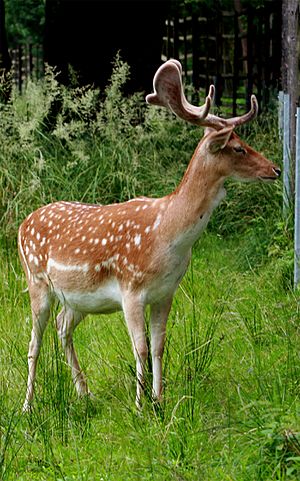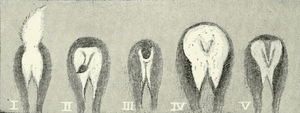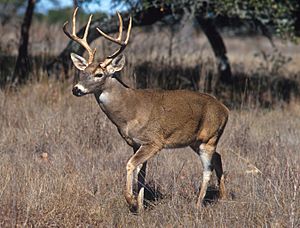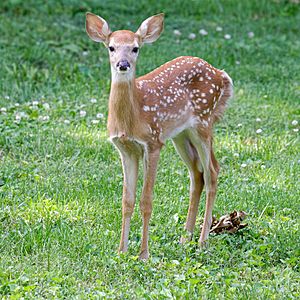Deer facts for kids
Quick facts for kids DeerTemporal range: Early Oligocene – Recent
|
|
|---|---|
 |
|
| A fully grown male Red deer | |
| Scientific classification | |
| Kingdom: | |
| Phylum: | |
| Class: | |
| Order: | |
| Suborder: | |
| Family: |
Cervidae
Goldfuss, 1820
|
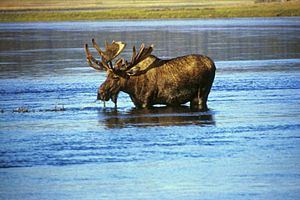

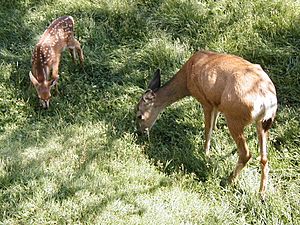
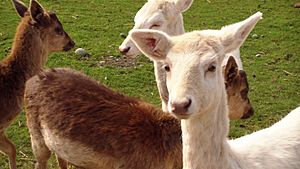
Deer are amazing mammals that have hooves with an even number of toes. They belong to a special group called the Cervidae family.
A male deer is usually called a stag or buck. A female deer is called a doe, and a young deer is known as a fawn.
There are about 60 different species of deer around the world. They first lived in the northern parts of the world. Today, you can find them naturally in Europe, Asia, North America, and South America. People have also brought deer to places like Australia, New Zealand, and South Africa.
In the wild, most deer live for about 3 to 5 years.
Contents
What Do Deer Look Like?
Deer are a very diverse group of animals. They look a bit like antelopes, but there's a big difference: deer have antlers, which they grow and shed every year. Antelopes, on the other hand, have permanent horns.
Deer typically have long, strong legs, a small tail, and long ears. Their size can vary a lot! The biggest deer alive today is the moose. It can stand almost 2.6 meters (8.5 feet) tall and weigh up to 800 kilograms (1,760 pounds). The elk is also large, standing up to 2 meters (6.5 feet) tall.
The smallest deer in the world is the northern pudu. It's only about 32 to 35 centimeters (12 to 14 inches) tall at the shoulder and weighs just 3.3 to 6 kilograms (7 to 13 pounds).
In most deer species, males are bigger than females. Also, except for the reindeer, only male deer grow antlers.
Deer coats are usually red or brown. Some, like the tufted deer, can be very dark brown. Others, like the elk, might have a grayish color. Some deer, such as the chital and fallow deer, have white spots on their brown coats.
Deer shed their fur twice a year. For example, a red deer's thin, red summer coat is replaced by a thick, grayish-brown winter coat in autumn. Then, in spring, the summer coat grows back. This shedding process is affected by how much daylight there is.
Deer are also great at jumping and swimming. They are ruminants, which means they chew their cud. They have a special four-chambered stomach to help them digest their food.
Almost all deer have a special gland in front of each eye. This gland makes a strong-smelling liquid called a pheromone. Deer use this scent to mark their territory, showing other deer where their home range is. Male deer often open these glands wide when they are angry or excited.
All deer have a liver but no gallbladder. They also have a special reflective layer in their eyes called a tapetum lucidum. This helps them see very well at night.
Antlers: What Are They For?
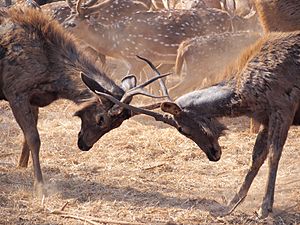
Most male deer have antlers. The only exception is the water deer, where males have long, tusk-like teeth instead. Female deer usually don't have antlers, but female reindeer do! Their antlers are smaller and less branched than the males'. Sometimes, females of other species might grow small, unusual antlers.
The fallow deer and reindeer have the largest and heaviest antlers. The tufted deer has the smallest antlers of all deer. The pudú has the lightest antlers.
Antlers come in many shapes. Fallow deer and elk have flat, broad antlers. White-tailed deer antlers have points (called tines) that grow upwards from a curved main beam. Pudú antlers are just simple spikes.
Antler growth starts from a bony bump on the skull called a pedicel. This appears when the deer is about a year old. The first year, a deer might grow a spiky antler. The next year, it will grow a branched one. This cycle of losing old antlers and growing bigger, more branched ones continues throughout the deer's life.
Antlers first grow as soft tissues covered in "velvet." This velvet is full of blood vessels. As the antlers grow, they harden into bone. The blood supply to the velvet stops, and the velvet peels off, leaving hard, bony antlers.
Antlers are very important for male deer. They use them mainly for attracting mates and for fighting with other males. The tines on antlers help them lock together during fights. This allows males to wrestle without hurting each other's faces.
A deer's antlers can show its place in the group. Heavier antlers usually mean a higher social status. Males with bigger antlers tend to be more aggressive and dominant. Large antlers can also be a sign of good health and strong genes. Males with bigger antlers often have better resistance to sickness and can have more offspring.
In places like Yellowstone National Park, elk antlers also help protect them from predators like wolves. Scientists have studied the branching patterns of antlers to understand how they are similar across different deer species.
Deer Teeth
Most deer have 32 teeth. They have a special dental setup. They don't have upper front teeth (incisors). Instead, they have a tough pad on their upper jaw. This pad helps them bite off plants.
The Chinese water deer, tufted deer, and muntjac have long, sharp upper canine teeth that look like tusks. Other deer species often don't have upper canines at all.
Deer have special cheek teeth with ridges. These ridges help them grind up all the different plants they eat.
What Do Deer Eat?
Deer are mostly browsers. This means they eat leaves, twigs, and other plant parts. They also eat grasses, sedges, and small plants called forbs. In northern areas during winter, they might eat lichens.
Deer have small stomachs compared to other ruminants. They need food that is easy to digest and full of nutrients. Instead of eating huge amounts of tough, fibrous plants like cows or sheep, deer choose soft twigs, young leaves, fresh grasses, fruits, and fungi. This easily digested food moves quickly through their bodies.
Deer need a lot of minerals, like calcium and phosphate, to help their antlers grow strong. This is another reason why they need a diet rich in nutrients.
How Do Deer Behave?
Deer don't build nests or dens. They find safe, comfortable spots to rest, often under low-hanging tree branches. They like to stay close to where they can find food.
In summer, deer eat grasses, plants, and weeds. In the fall, they enjoy mushrooms and small branches. They don't store food for the winter. If the snow isn't too deep, they use their hooves to dig up moss and leaves. If the snow is deep, they eat twigs and branches from trees.
A female deer (doe) usually gives birth to 1 or 2 fawns in the spring. A fawn can stand up right after it's born, but it's still weak. The doe will hide each fawn in a different place to keep them safe. Fawns have spots on their backs, which helps them blend in with their surroundings and stay hidden.
Who Are Deer's Predators?
Deer have many natural enemies. Wolves, cougars, and dogs are some of their predators. People also hunt deer. Deer are always alert, using their excellent sight, hearing, and smell to detect danger. They can usually run faster than their predators, which helps them escape.
How Did Deer Evolve?
Deer are a group of animals that all came from a single ancestor. They first appeared in the northern hemisphere. Much later, some deer traveled to continents that were once part of Gondwana, a supercontinent. For example, Red deer are found in the Atlas Mountains of North Africa. Some deer also arrived in South America during a time when animals moved between North and South America.
In Africa, south of the Sahara Desert, you mostly find antelopes instead of deer. Antelopes fill a similar role in the environment there as deer do in other parts of the world.
Images for kids
-
"The Stag Hunt of Frederick III, Elector of Saxony" by Lucas Cranach the Elder, 1529
-
Chital deer in Nagarahole, India
-
Reindeer herds standing on snow to avoid flies
-
Some sika deer (Cervus nippon) and Japanese macaques (Macaca fuscata) along a waterside
-
A Roe deer browsing tree leaves in Brastad, Sweden.
-
Upper Palaeolithic cave painting of a Megaloceros giant deer at Lascaux, 17,300 years old
-
Ancient Greek gilt-silver rhyton, 4th century BC
-
Bronze deer, Warring States period
See also
 In Spanish: Cérvidos para niños
In Spanish: Cérvidos para niños


